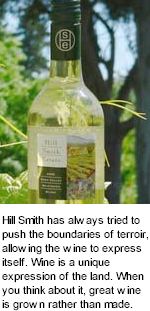


Since the first wine was released in 1981, Hill Smith Estate Sauvignon Blanc has earned itself a reputation as one of Australia's most awarded Sauvignon Blanc wines. Over two decades of this estate grown wine have been awarded no less than 7 trophies, 18 gold, 43 silver and 79 bronze medals. The distinctive label, featuring an original painting of the vineyard by founder Wyndham Hill Smith, combines the tradition at the heart of the Hill Smith family with the contemporary styling befitting a modern Australian classic.

What does it take to produce a classic? In the case of Hill Smith Estate Sauvignon Blanc it's a combination of tradition, know how and passion. When those qualities work together with the soil and climate of one of South Australia's premium wine growing regions, the result is a wine of outstanding elegance and character that is a classic in any sense of the word. The greatest contributor to any wine is undoubtedly nature itself, and at Eden Valley nature has been bountiful indeed.
With rocky, acidic soil, abundant winter rainfall but dry summers, the Valley provides ideal growing conditions. Careful management and clonally selected grafted vines ensure consistent quality and flavour. The high altitude (510 metres above sea level) provides a cool climate that extends the growing season, delaying harvest and enabling the fruit to mature slowly, enhancing and concentrating its flavours.
Surrounded by Conservation Park and dedicated to Sauvignon Blanc, Hill Smith Estate Vineyard adopts an environmentally friendly approach combined with modern viticulture and winemaking skills. The vines are encouraged to grow leafy, shady canopies that not only protect the grapes but provide shelter for the many kangaroos that also call the vineyard home.
Hill Smith Estate has always tried to push the boundaries of terroir, allowing the wine to express itself. Wine is a unique expression of the land. When you think about it, great wine is grown rather than made. Hill Smith Estate Sauvignon Blanc traditionally is known as a zingy, fresh and intense style of Sauvignon Blanc. The winemaking should continually challenge traditional style and strive to further refine and evolve the wine.
The Hill Smith Estate vineyard always manages to grow dense, healthy canopies, which are perfect for shading the grapes during summer, resulting in the intense varietal characters and high natural acidity, so typical of the estate. The grapes are picked overnight in the cool, then crushed and de-juiced quickly before being clarified. Aromatic yeast strains are chosen and cool fermentations result in lifted fruit aroma and flavour. About 34% of the wine was fermented and matured in fine grained new French oak Barriques and Puncheons for over three months. This has helped add another dimension of subtle flavour, texture and complexity to the wine.